#touhou character ages
Explore tagged Tumblr posts
Text
Touhou Character Ages, an imperfect and incomplete and provisional guide:
Part 1: Over a thousand years old.
Eirin Yagokoro: predates the formation of Japan (Omoikane is the child of the primordial creation god Takamimusubi in the Kojiki), so depending on how you date this, she could be over 130 million years old (beginning of the subduction of the Izanagi Plate) or as young as 2 million years old (date Honshu, Kyushu, and Shikoku separated from the mainland). Neo-Traditionalism of Japan says 25 million years for the Izanagi Object mentioned.
Hisami Yomotsu: A yomotsu-shikome with a grape motif, she presumably is one of those who chased Izanagi and would be of a similar age, 25 million years or so.
Keiki Haniyasushin: Haniyasu is another god from Izanagi Times.
Junko: Her euhemerized backstory with Hou Yi places her as dating back to the Xia, traditionally dated as ruling 4000-3800 years ago.
Chang'e: Must be at least as old as Junko.
Yukari Yakumo: Of uncertain age, definitely 1200+(Merry's age at time of disappearance) thanks to Akyuu, implied to be the oldest youkai in Gensokyo and thus would have to be older than Tewi, so a minimum of about 3000 years old.
Hecatia Lapislazuli: attested to by Hesiod in the Theogony, is already an established mythological figure, at least 2700 years old and probably significantly older.
Suwako Moriya: Older than Kanako by their backstory, and a Jōmon goddess. At least 2300 years old if we use the current dating for the end of the Jōmon period, 2700 if we use the traditional date for the arrival of Jimmu, probably much older.
Tewi Inaba: If she's literally the Rabbit of Inaba, then she's as old as Ōkuninushi and thus older than Kanako.
Sagume Kishin: A Kojiki figure from the same period of heavenly gods conquering Japan. In the same age bracket as Tewi and Kanako at minimum, quite possibly older.
Kanako Yasaka: Dates back to the conquest of Japan by the heavenly gods. At least 2700 years old with a slightly euhemerized interpretation, possibly older.
Seiga Kaku: Might be as old as the Eastern Han (so 2000-1800 years old), given esoteric Taoism being popular then, but more likely is visually intended to be from the Tang, another period for esoteric Taoism. She must be old enough to be an established corrupt immortal when she met Miko, though. So at least 1400, probably at least 1500 years old.
Okina Matara: From her comments on Eternity Larva, she was Hata no Kawakatsu and so appeared sometime in between the years 509 and 571, though quite possibly had some kind of preexistence as Matarajin. Definitely older than Miko.
Eternity Larva: The tokoyo god's cult was defeated and exposed by Hata no Kawakatsu.
Toyosatomimi no Miko: Has a defined birthday (February 7th, 574) from being a historical figure and so turned 1,449 this year.
Mononobe no Futo: Contemporary of Miko.
Soga no Tojiko: Contemporary of Miko.
Hata no Kokoro: Made by Miko for Okina.
Saki Kurokoma: Was Miko's horse before she was sent to the Asuka period glue factory and became an animal realm gangster.
Watatsuki no Toyohime: Eirin's pupil before she left in exile, older of the two sisters, almost certainly much older than this.
Watatsuki no Yorihime: Younger than Toyohime by definition but the rest applies as well.
Kaguya Houraisan: Definitely existed for some time before being exiled to Earth when Fujiwara no Fuhito was alive. At least 1400 years old, almost certainly much older.
Fujiwara no Mokou: Presumably a child of Fujiwara no Fuhito and thus about 1340-50 years old.
Minamitsu Murasa: Had been a phantom for enough time to become a local legend before Byakuren arrived. At least 1100 years old.
Byakuren Hijiri: Sister of Myouren, who lived in the 9th century. At least 1100 years old.
Shou Toramaru: Follower of Byakuren, must be of roughly similar age.
Ichirin Kumoi: Follower of Byakuren, must be of roughly similar age.
Nazrin: Attendant of Vaisravana/Bishamonten, is at least of similar age to Shou and possibly older.
Nue Houjuu: At least 900 years old going by her being the nue Minamoto no Yorimasa shot at, but knew Murasa and so is at least old enough to have interacted with her before Byakuren's followers got jailed.
Suika Ibuki: Fought the ara ara lady with balloon tits from Fate franchise media, which makes her at least 1000 years old. At least a little older, most likely.
Kasen Ibaraki: Contemporary of Suika.
Yuugi Hoshiguma: Contemporary of Suika.
Aya Shameimaru: Over a thousand years old according to PoFV.
I can't help but feel I'm missing some.
19 notes
·
View notes
Text
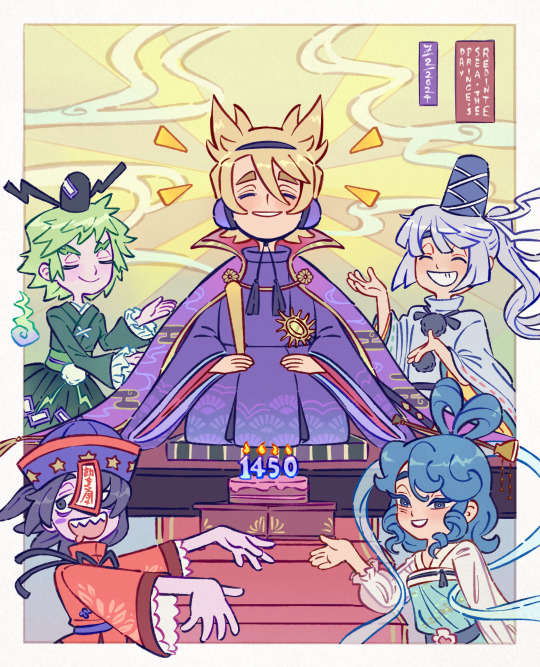
Here's this year's annual birthday illustration!!! I think this one is my favorite one so far, happy shared birthday Miss Crown Prince! Spare me some of your long lifespan... 🥂🎂🎉
(+stupid silly discord interaction doodle featuring improvised funny touhousonas under the cut)
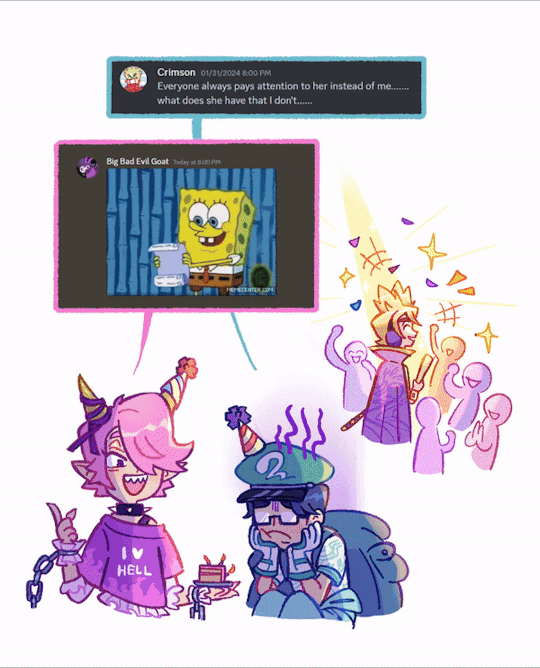
#touhou#touhou project#2/7#toyosatomimi no miko#miko day#mononobe no futo#seiga kaku#soga no tojiko#yoshika miyako#me art#artists on tumblr#I am no longer the funny song age. welcome sweet terrible 24#I love celebrating my birthday by ignoring myself and focusing on fictional characters who share it w me instead. very fun would recommend#I based my friends oni sona on their design of their fusona!!! they are @candybaphomet here and they are very funny as you can tell
690 notes
·
View notes
Text

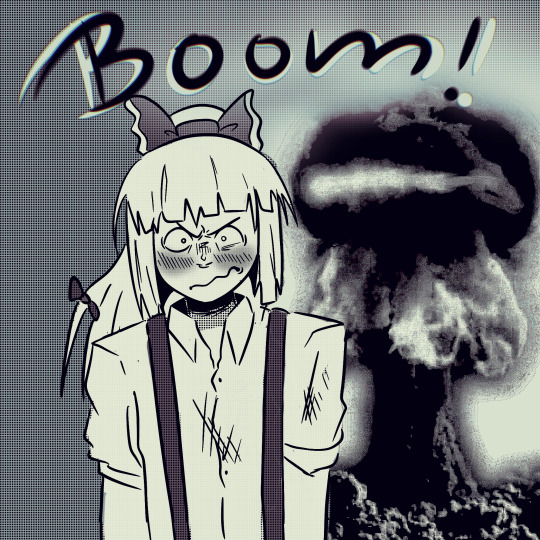
I'm back on my TeruMoko shit
#pepperjackart#touhou#fujiwara no mokou#touhou project#kaguya houraisan#terumoko#cw // suggestive#cw smoking#any character i draw in suggestive situations is above the age of 18
1K notes
·
View notes
Text

[Click image for better quality]
I FIGURED OUT A WAY TO FUCKING MAKE THE IMAGE SMALLER FOR POSTING ON TUMBLR WITHOUT SACRIFICING THE ACTUAL QUALITY OF THE IMAGE OH MY GOD
Ok so, what I did is go into the clip studio paint file, make a new file, copy and paste the group in the original file, merge everything, get rid of the extra stuff outside of the canvas, and then make the flattened image smaller and crop the canvas. Once you have that, export it and you're done. This helps maintain the actual quality of the image and also helps shrink the file size down to something actually postable (if anyone has a better way of doing this please tell me)
[Edit]: Ok I guess posting something to Tumblr just naturally compresses the image a bit more somehow because I'm looking at it now and zooming in too much makes it a bit blurry so I'm still gonna have to futz around with image quality for future pieces oof
Artist's Note:
I'm so glad I figured out a way to do this because I like working on a big canvas so I can get as much detail in as I possibly can. Only problems are how laggy it gets while drawing lol.
I had an idea for a drawing with Reimu and Zanmu because I really like thinking about their potential dynamic a lot. I also wanted an excuse to draw Zanmu again but in my normal rendering style because last time I drew her she was in my more sketchy style with generally flat colours so I wanted to draw her again. Speaking of, looking at the sketch for this is a jumpscare that I never enjoy seeing, like, man am I glad I didn't use those for my final piece.
Also about her spear. I was originally gonna make it like the ones she had in game, but it kinda threw off the whole piece. It was too big, too blue, and too flat, so I just went "fuck it" and gave her a different one instead. My headcanon justifying this is that the ones she uses in game are for danmaku battles whereas in any other fight she just uses a proper yari, or she still uses the yari and just makes it all glowy to power it up, maybe both lol. I pulled as much inspiration as I could from Sengoku era spears, and even put in some blue into the decorative part of the spear and also added a little skull to pay tribute to the original spear. Also, in my research I saw some art of izanami and izanagi making japan and saw that the yari izanagi has had a little decorative tassley thingy on it so I took some inspo from that and just made it one of Zanmu's tassles (Idk when that art was from or if the spear was still accurate to Sengoku period Japan but hey, probably the same reasons Eirin puts little bow ties on her arrows, it's just for personalization purposes).
I love rendering hair and clothes so much omg, while I like the super curly hair Zanmu, the longer, wavier hair suits her better for this drawing (I imagine it only does that like how Ghibli characters hair moves when they feel angry lol). I love making Zanmu's hair all messy and crazy, as well as giving her grey hairs, this woman has aged like a fine wine. Also, if the hem on the ends of her sleeves, top of her shirt, and her pants look like gold to you, that's because it is! It's fairly light so she's not collapsing under the weight, but it's gold! (I don't care how impractical it is, it's just cool). Not the undershirt though, it's made of a gold fabric. I had a cute idea with Reimu's hair to make it have a red shine to it. I also changed up Reimu's outfit so it isn't just a blob of red. I like it a lot when Reimu's skirt and outfit is segmented into different layers, so I wanted to incorporate that.
I tried to draw their hands differently as well, but IDK how noticeable that is. Also, I am super happy with how the side profiles for the two of them turned out, I used to struggle a lot with how to make the side profile of a character actually look like the character, so I'm really happy that they actually look like themselves.
Also added in the tree and rocks in the background as an homage to Zanmu's character art in Touhou 19, just because I was getting kinda stumped on what to do with the background lol.
In terms of a story idea with Reimu and Zanmu, idk why but the potential plotline of Zanmu wanting to ascend to godhood is so fascinating to me. Like, it is very possible that if she just convinced everyone she was a god (which would be very easy for her to do), she would become one in a heartbeat. Also, if she were to become a god, with her ability to return stuff to nothing, could she hypothetically get similar abilities to (Jojo Part 5 spoiler btw) GER? Like, idk about the death timeloop stuff, but the concept has been haunting me every night as I have been trying to find loopholes in GER's ability for a while now ( for no reason in particular). Back to the main topic, I imagine that she would probably tell Reimu that if she were to become a god she would take over the Hakurei shrine since the god there might as well be dead, and Reimu just says to her, "Over my dead body bitch." Like, I have no idea how to summarize their dynamic but like, it's the type of hero-villain dynamic where the phrase "We're not so different, you and I" would definitely be a phrase said during a fight. I think that if another IN style game were to release, Reimu and Zanmu would be in a team together. They could also have an interesting mentor and pupil kind of dynamic. Can you tell that Zanmu has been charging my mind rent these part few months? Like, instead of living in my head rent free, she kinda just uno reversed the whole situation and now she's the one charging me rent. What happens if I get evicted from my own brain? Actually, scratch that, I don't think I wanna know.
#touhou project#art#fanart#touhou fanart#touhou 19#touhou#東方project#zanmu nippaku#unfinished dream of all living ghost#reimu hakurei#東方
276 notes
·
View notes
Text
Demon king, demigod, drunkard, dōji: exploring the archetypal oni, from Ōeyama to Lotus Eaters
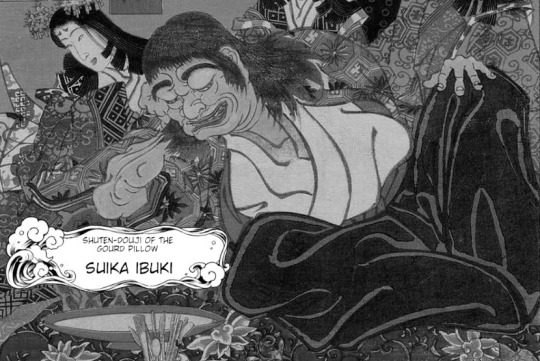
By popular demand, I wrote an article covering the background of Shuten Dōji and his underlings, and how it influenced Suika’s character and the idea of the Four Devas of the Mountain in Touhou. It was initially scheduled for last month, but I’ve experienced unplanned delays. Read on to learn if you want to learn what Suika has to do with Yamata no Orochi and Mara, if it’s true that oni never lie, and more. I will also explain why making your own fourth Deva of the Mountain is entirely fair game and anyone telling you otherwise is wrong about the source material which inspired ZUN. The article contains some spoilers for WaHH and a number of other Touhou installments, so proceed with caution if that might be an issue for you.
Ōeyama, or Shuten Dōji: origins
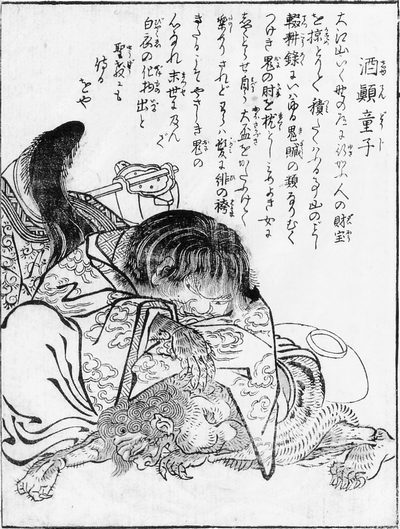
Shuten Dōji, as depicted by Sekien Toriyama in Konjaku Gazu Zoku Hyakki (wikimedia commons)
It perhaps seems a bit silly to start this article with an inquiry into the identity of Shuten Dōji (酒呑童子, “wine-loving youth” or something along these lines). After all, while Touhou characters are often based on obscure figures, Suika is hardly an example of that category. Shuten Dōji is arguably THE archetypal oni, known even to people with limited familiarity with Japanese mythology and folklore. And yet, the matter is nowhere near as clear cut as it might seem at first glance. From a certain point of view, Shuten Dōji might not even exactly be an oni, strictly speaking. A book from Nara simply titled Ōeyama ("Mt. Ōe") offers a detailed account of Shuten Dōji’s origin. His father was not a man or a demon, but rather a mountain god, Ibuki Daimyōjin (伊吹��明神). That’s not all, though - according to a local belief, Ibuki Daimyōjin was actually Yamata no Orochi. How does that even work? Contrary to the more widespread tradition, the inhabitants of the area around Mt. Ibuki from the Muromachi period onward believed that Orochi survived his confrontation with Susanoo and hid in the mountains. That’s actually not even the most unusual variant tradition about Orochi. A widespread belief through the middle ages was that he eventually managed to redeem himself, becoming a divine dragon (shinryū, 神龍) residing in the dragon palace under the sea. In that capacity, he was sometimes associated with emperor Antoku, with the latter even claimed to be his reincarnation, for example in a local legend associated with the Atsuta Shrine, preserved in the noh play Kusanagi. In esoteric Buddhist doctrine Orochi was sometimes perceived as a local manifestation (suijaku) of the buddha Yakushi - much like Susanoo was. Ichijō Kaneyoshi in his Nihon shoki sanso (1455–1457) went into yet another direction, presenting the snake as identical with the naga girl from the Lotus Sutra. Apparently, he specifically means the version of her from Shaku Nihongi… who is identified there as Susanoo’s wife, down to being equated with Kushinadahime (this was not unusual in itself - Susanoo was equated with Gozu Tennō based on similar character, so it was sensible for their wives to be seen as analogous). This effectively created a scenario where Susanoo married his nemesis.

A Japanese depiction of the naga girl offering a jewel to the Buddha, as described in the Lotus Sutra (wikimedia commons)
Anyway, back to Shuten Dōji. According to Ōeyama, Ibuki Daimyōjin, before he even came to be known under this name, fell in love with the daughter of a local feudal lord, Sugawa. He started visiting her at night and she as a result eventually became pregnant. The identity of the visitor was unknown to her father, and out of frustration and fear that nefarious supernatural forces might be involved he eventually contacted various religious officials to perform exorcisms. Needless to say, Ibuki Daimyōjin was less than thrilled, and decided to display his divine wrath through rather conventional means: Sugawa was struck by illness. He once again summoned various Buddhist monks and onmyoji, this time to attempt to heal him. They concluded that the disease will disappear if the deity who caused it is properly honored, and established formal worship of Ibuki Daimyōjin, which apparently did indeed help. Sugawa’s daughter eventually gave birth to Ibuki Daimyōjin’s child. The child started to cause problems at the age of three: his love of alcohol manifested for the first time, earning him the moniker of Shuten Dōji. By the time he was ten, his misdeeds were too much for his family to bear with and his grandfather decided to send him to Mt. Hiei to become a novice (chigo). The monastic lifestyle didn’t really change much though, and Shuten Dōji continued to drink. Eventually he managed to convince three thousand monks (sic) to drink with him and to join him in an “oni dance” during which everyone put on masks representing demons. The festivities lasted seven days. When Shuten Dōji woke up afterwards, he realized his mask had fused with his face, and he was no longer able to take it off. The other participants fled out of fear of his new form.
Shuten Dōji’s Mt. Hiei career was subsequently cut short by Saichō, the founder of the Tendai school of Buddhism. After learning what happened, he prayed to the buddha Yakushi and to Mt. Hiei’s protective deity Sannō Gongen to banish Shuten Dōji. It's worth pointing out that presenting young Shuten Dōji and Saichō as contemporaries is basically standard, and pops up in multiple legends. There are variants where Kūkai, the founder of Shingon, plays a similar role instead, to. They actually lived some 200 years before the other historical figures who appear in Shuten Dōji narratives, but this is not an oversight. It is a given that a partially divine being would live for much longer than a human.

A Heian period portrait of Saichō (wikimedia commons) As a result of Saichō’s success, Shuten Dōji had to flee. He tried to return to his grandfather’s residence, but this was no longer an option for him. He temporarily hid on Mt. Ibuki, but eventually left for Mt. Ōe, where he finally became a veritable "demon king".
The reason why Shuten Dōji was rejected by his family is that he was recognized as an “oni child” (鬼子, onigo). In the folkloric sense, this term refers to supernatural beings which are nonetheless partially human by birth. Not necessarily part oni, though. Another well known onigo, Sakata no Kintoki, was the son of a yamauba, for instance. However, Yanagita Kunio noted that this term also referred to children born with teeth (a real, though very uncommon phenomenon), who were believed to turn into oni - much like how Shuten Dōji did. He states that especially before the Edo period this lead to cases of child abuse or outright murder. In some cases sending the child to become a member of Buddhist clergy was seen as a remedy. For example, a twelfth century monk named Jōjin in a letter relays that he suggested this to the mother of such a newborn. It is not hard to see that Ōeyama likely consciously references this custom.
The other origin of Shuten Dōji
Yet another tradition is preserved in a variant of the standard Shuten Dōji tale which switches the location of his demise from Mt. Ōe to Mt. Ibuki: here Shuten Dōji is not just any demon, but a manifestation of Mara. As in, the opponent of the Buddha and demon king of the sixth heaven, not some other accidentally similarly named figure.
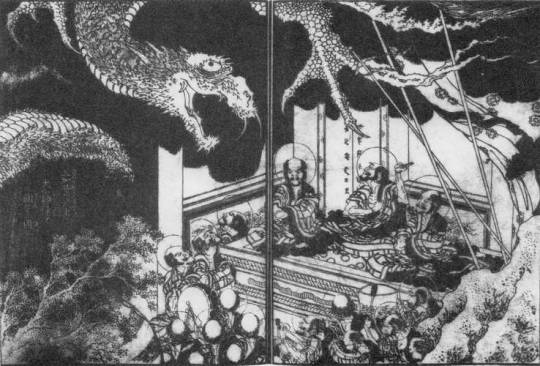
Mara, as depicted by Hokusai in Shaka-goichidai-zue (wikimedia commons)
It is presumed that this portrayal of Shuten Dōji might be tied to medieval Japanese traditions pertaining to Mara. They might sound unusual today: he was both a “demon king” (魔王) obstructing enlightenment, as expected, but also a jinushi (地主), or “landholder deity”. From the Buddhist point of view, jinushi were ambivalent figures: on one hand, their presence was responsible for bestowing specific locations with holiness. On the other hand, they could resist Buddhism as demonic forces, and had to be subjugated or converted to prevent that. Mara was the ultimate jinushi, the king of the world as a whole. A role already attributed to him in earlier Buddhist sources was basically adjusted for this framework. The jinushi version of Mara originated among proponents of the imperial court and mainstream Buddhist institutions, but it curiously also gained traction among the opponents of these structures. Mara became somewhat of an anti-establishment icon more than once, essentially. A legend links him with (in)famous rebel Taira no Masakado (who you may know from SMT) for this reason.
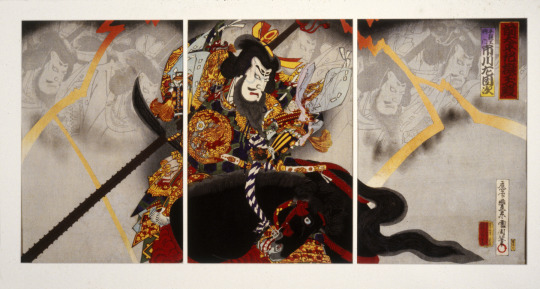
Masakado, as depicted by Kunichika Toyohara in Sen Taiheiki Gigokuden (wikimedia commons)
Other similar examples are also known. A local legendary figure from the Tsugaru peninsula in modern Aomori prefecture, Tsugaru Andō (津��安藤), who after a failed rebellion fled to Hokkaido, was proudly described as a vassal of Mara by local officials who claimed descent from him. Prince Sutoku, a banished opponent of emperor Go-Shirakawa, swore a vow to become like Mara. Oda Nobunaga famously referring to himself as the “demon king of the sixth heaven” in a letter to Takeda Shingen is likely another example. Reportedly a related belief that praying to the jinushi version of Mara can spare one from conscription persisted as late as the early 20th century, though generally he belongs to the realm of “medieval myths” which faded with the ascent of a new system of values in the Meiji period, in which the early imperial chronicles were favored. Even though it is largely forgotten today outside of specialized scholarship, there is much more to this Mara tradition. It led to the development of one of my favorite Japanese myths with no popcultural reception, but you will have no wait a few more weeks to learn more. It has been argued that behind the identification of Shuten Dōji and Mara might reflect a historical event of the sort which led to associating the latter with figures such as Masakado. In other words, that Shuten Dōji in this case might be less a demon and more a demonized form of some opponent of imperial or religious authorities.
It has been argued that the Ibuki version was the result of combining an original oral narrative, a precursor of the textual versions we are familiar with today, with the memory of the death of a certain Kashiwabara Yasaburō, a bandit leader, in 1201. It has in fact been argued that even the mt. Ōe version might simply be a particularly fabulous reinterpretation of a punitive mission against bandits robbing and murdering travelers. Such rationalist explanations are not exactly new - Ekken Kaibara already argued in the Edo period that the legend of Shuten Dōji must have been the reflection of the downfall of a real bandit who perhaps wore the mask of an oni while committing robberies.
It’s important to bear in mind to not go overboard with this speculation, though. Ultimately the Mt. Ibuki version has a more pronounced religious character than other variants in general: Shuten Dōji’s nemesis Raikō’s is identified as a manifestation Bishamonten or Daiitoku Myōō (in the latter case, Bishamonten and the three other heavenly kings correspond to his four retainers), emperor Ichijō with Miroku (Maitreya), and Abe no Seimei, who plays a minor role in vanquishing the demon, with Kannon. These equations reflect the idea of honji, or “true nature” of Buddhist figures, who were believed to take various guises through history to help people reach nirvana, for example these of local deities or historical figures. The best known example of application of this doctrine in Japanese Buddhism is obviously the historical phenomenon of honji suijaku, which was focused specifically on kami.
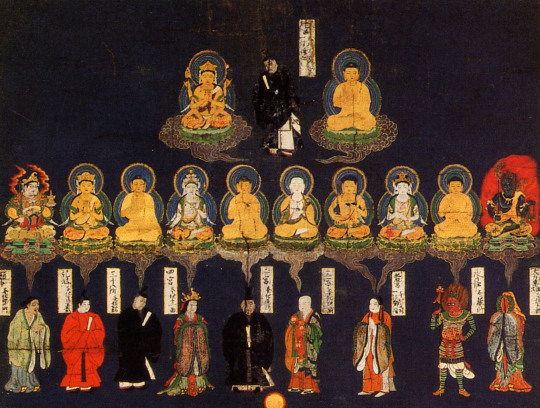
A Kasuga mandala representing the correspondences between Buddhist figures and local kami (source; reproduced here for educational purposes only)
The legend of Shuten Dōji
Regardless of which mountain is identified as the residence of oni, and of whether the dramatis personae are identified with Buddhist figures or not, the plot of the various versions of the legend of Shuten Dōji surprisingly does not vary all that much. While it is reasonably well known, I figured it won’t hurt to summarize it here anyway, especially since the information above should make it possible to view it from many new angles.
The oldest surviving version, Ōeyama Ekotoba (“Illustrations and Writing of Mt. Ōe”), presumably based on preexisting oral sources, comes from the fourteenth century, specifically from the Nanbokuchō period. However, the story only reached the peak of its popularity a few centuries later, in the Edo period. This was a part of a broader phenomenon: preexisting tales about warriors matched the sensibilities of the new ruling classes and were kept in circulation by them, but eventually they also became a part of urban popular culture. Many adaptations were produced, including noh plays and ukiyo-e. To put it very colloquially, the heroic warriors and demon quellers from the previous periods became the Edo period counterpart of contemporary superhero media. This is a genuine comparison employed in scholars, for clarity, not a joke. As remarked by Bernard Faure, the most widespread version is basically framed as if it was a tabloid story from the Heian period. In 995, young women (and in some versions men too) disappear whenever a particularly violent storm occurs, and nobody knows how to stop it. Not even the power of Buddhist exorcisms is enough. Seeing as in the portrayed time period that was pretty much the universal solution to supernatural problems, this is a big deal.
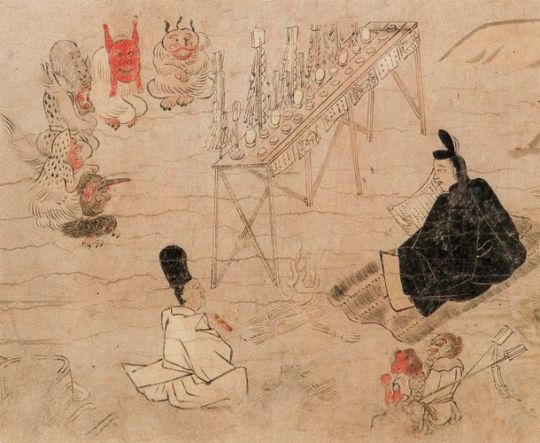
Abe no Seimei (right) in the Fudo Rieki Engi (wikimedia commons) This is a source of distress for a certain official, Ikeda Kunikata (or, in some version, Kunitaka), whose only daughter is among the kidnapped women. He decides to seek the help of the Heian period superstar Abe no Seimei, arguably the most famous onmyoji in history. Alternatively, the expert contacted is a certain Muraoka no Masatoki, who to my best knowledge is a fictional character and doesn’t appear anywhere outside of some variants of this tale. Either way, thanks to this intervention it is possible to identify the culprit as a demonic being residing on Mt. Ōe (or alternatively on Mt. Ibuki). In one of the versions featuring Seimei he specifically identifies him as a tenma (天魔), “heavenly demon” - a term commonly used to refer to tengu (as ZUN does in Touhou) and to servants of Mara (overlapping if not identical categories, really; stay tuned for a future article exploring this). However, onmyoji arts are not enough to stop the crisis; all Seimei can guarantee is that Kunikata’s daughter will survive, but he has no way to confront the demon directly. Kunikata therefore decides to bring the case to the attention of the emperor, Ichijō. He holds a meeting with various ministers, who note that in the past a similar case was solved by Kūkai (recall his already mentioned association with Shuten Dōji). However, there are no monks of equal skill left, so his feat cannot be repeated.
It is then concluded that the only way to end the demon’s reign of terror it is to send the strongest warrior they were aware of, Minamoto no Yorimitsu (Raikō) and his four retainers, Watanabe no Tsuna, Sakata no Kintoki, Taira no Suetake, and Tairi no Sadamitsu, on a mission to kill him. Raikō is also assisted by Fujiwara no Yasumasa (Hōshō) and his anonymous attendant, but these two never gained much prominence as characters in this narrative. Additionally, in some versions other figures from the same period - Taira no Muneyori, Minamoto no Yorinobu (Raikō’s younger brother) and Taira no Korehira - are namedropped as potential candidates considered by the emperor, but they all reportedly decline to partake out of fear.
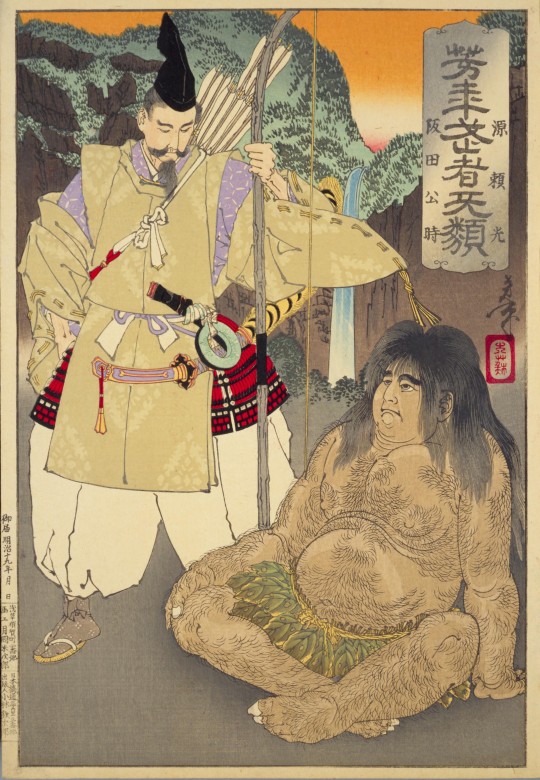
Raikō and Kintoki, as depicted by Yoshitoshi Tsukioka (wikimedia commons)
Preparations started with prayers in Sumiyoshi, Kumano, Kasuga and, in some versions, Hie shrines. They did not go unanswered. Raikō and his retainers subsequently encounter a group of shugenja (mountain ascetics) who turn out to be the manifestations of the deities they paid honor to: Sumiyoshi Myōjin, Kumano Nachi Gongen, Hachiman (here addressed as a bodhisattva) and, if the Hie shrine is included in a given version, Sannō Gongen. They explained that to safely enter the fortress of Shuten Dōji, Raikō and his men must disguise themselves as shugenja (that’s because the legendary first shugenja, En no Gyōja, famously had an entourage of demons). They also provide him with supernatural wine. They state the oni will inevitably drink it due to their fondness of alcohol, only to end up poisoned as a result. In some versions they vanish afterwards, but in others they continue to accompany Raikō. The protagonists then encounter a woman washing blood stained clothes. In some versions she is described as elderly, and states she has lived for 200 years as a servant of Shuten Dōji. In the most widespread Edo period version, she is young and says she was only kidnapped a year earlier, though.
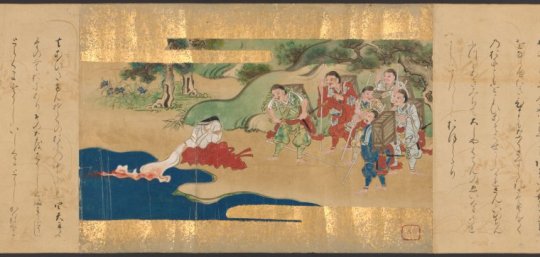
Encounter with the woman washing bloody clothes (NYPL Digital Collections) Regardless of her age, she reveals some additional information about Shuten Dōji, though that also varies depending on the version. In some, she explains that he looks like a human during the day, but takes the form of an oni at night. His human form is specifically that of a dōji, literally “child”, but we’ll get back to the full context of this term later. In any case, I think it's safe to say the shape and size changing is where Suika'a ability came from. In another variant, the woman warns the heroes that Shuten Dōji is enraged by Abe no Seimei’s actions, as the onymoji apparently figured out in the meanwhile how to keep the people of Kyoto safe by employing a number of shikigami (a standard part of his repertoire). There are no further stops on the journey, and shortly after the encounter with the woman of variable age Raikō and his men enter the mountainous land of the oni. Especially in the older versions, it’s a place completely out of this world, with all four seasons occurring at once. Once they enter the fortress located there, they instantly encounter Shuten Dōji… and ask him for a place to stay for the night.

Distinctly human-like Shuten Dōji, as depicted by Yoshitoshi Tsukioka in One Hundred Ghost Stories from China and Japan (LACMA; reproduced here for educational purposes only)
Rather unexpectedly, he instantly agrees. He then tells them about his past; this largely a shorter version of the legend already discussed earlier, though with nothing predating the Mt. Hiei section mentioned. We also get a specific date for his arrival on Mt. Ōe, 849. This doesn’t last long, though, and soon he invites the protagonists to partake in a feast with him. This is obviously not a regular party, and while the individual versions can be more or less graphic, it is clear that the oni are consuing the flesh and blood of their captives. Despite various horrific sights, Raikō maintains composure. He uses the opportunity the feast presents him with to offer Shuten Dōji the sake he received from the three (or four) deities earlier. As expected, Shuten Dōji gets drunk, and leaves to rest in his chamber.
The other oni continue to party. In some versions, some of them try to approach the protagonists by disguising themselves either as a group of courtly ladies or as a dengaku troupe, but Raikō’s glare is so intense they quickly relent. Eventually all of the oni give up on attempting to engage with the alleged ascetics and end up drunk. That’s when the heroes decide to free their captives. These obviously include the women from Kyoto. However, as it turns out, Shuten Dōji’s rampages actually extended beyond Japan, to India and China, though only captives from the latter area actually appear. Multiple versions additionally mention that one of the prisoners was a young acolyte of the Tendai abbot Ryōgen, who was protected by assorted deities. This doesn’t really come into play in any meaningful way, though. Once everyone is freed, the heroes draw their weapons and enter Shuten Dōji’s chamber.
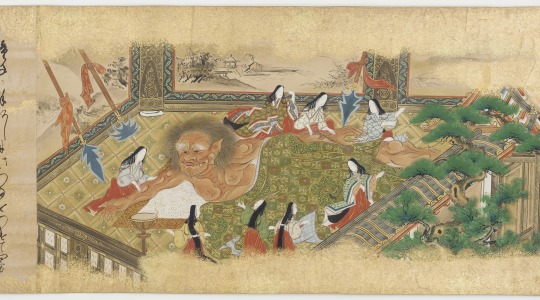
Sleeping Shuten Dōji (National Museum of Asian Art; reproduced here for educational purposes only)
The protagonists finally witness Shuten Dōji's oni form. He is five jō (around fifteen meters) tall, has fifteen eyes and five horns. His head and torso are red, his right arm is yellow, his left arm is blue, his right leg is white and his left leg is black. This might be a reference to the five elements. Alternatively, he could be described as entirely red, which might either be yet another way to reference his love of alcohol, as in the case of the shōjō, or an indication he was comparable to a “plague deity” (疫神, ekijin). The manifestations of the deities from earlier show up again, this time to hold Shuten Dōji in place so that Raikō can strike. He cuts off his head, but to his shock it rises into the air and starts talking.
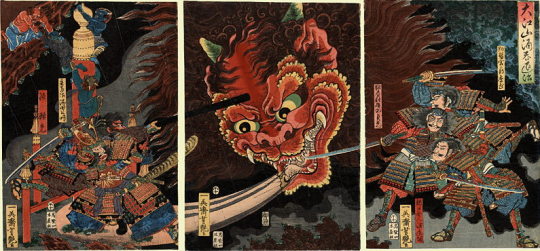
Confrontation between the heroes and the floating head of , as depicted by Yoshitsuya Utagawa (wikimedia commons)
Shuten Dōji actually mocks the heroes: “How sad, you priests! You said you do not lie. There is nothing false in the words of demons.” Needless to say, his final words are pretty directly referenced in Touhou. Oni, at the very least, claim they do not lie. Mileage of course varies, though. ZUN is not the only author drawn to this element of the legend. It would appear that even the Japan Oni Cultural Museum has advertised itself with the words “there is nothing false in the words of demons” in the past. As noted by Noriko T. Reider, emphasizing this apparent honesty (or naivete) sometimes serves as a way to make oni sympathetic or even relatable for modern audiences. However, it's worth noting that in the noh version, Raikō pushes back against Shuten Dōji’s words, and points out even the claim oni do not lie is a lie. He has a point, considering some versions outright establish oni capture their victims by disguising themselves as people close to them, imitating their voices. It probably also should be pointed out that in Konjaku Monogatari, oni are said to be scary precisely because they can tell apart right and wrong.
Anyway, oni ethics aside, it turns out that to kill Shuten Dōji for good, one has to gouge out his eyes. Once that is accomplished, Raikō's mission is finally complete. After killing the other oni, the protagonists take the head with them to Kyoto. Obviously, they also take the freed captives with them. The young women return to their families, and the Chinese men head for the coast to find a ship which could take them home. They promise to let the emperor (the Chinese one, for clarity; that would be Zhenzong of Song in 995) about Raikō's heroism. In the versions where the woman washing clothes was elderly, rather than simply one of the young captives, on the way back the protagonists learn that she has passed away in the meanwhile, since her lifespan was unnaturally extended by Shuten Dōji. Once he died, so did she.
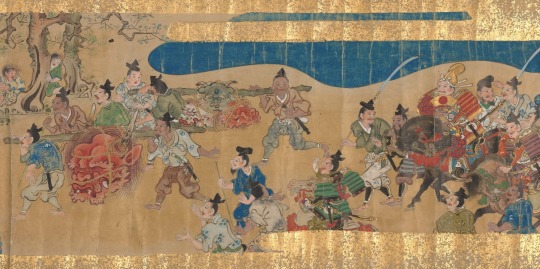
Transport of Shuten Dōji's head to Kyoto (NYPL Digital Collections)
Before the head can enter the capital, a purification ritual has been performed. Abe no Seimei thankfully knows how to do that. Thanks to him, all the relevant authorities can examine it. The emperor decides it will be best to store it in the treasure house of Uji. This location pops up in multiple legends. The severed heads of the two other equally famous malign entities, Ōtakemaru and Tamamo no Mae, were also stored there according to legends focused on them, in addition to various Buddhist relics and mundane treasures. In an alternate version, the head never reaches the imperial court. Raikō and his retainers encounter the bodhisattva Jizou, who tells them it is too impure to be shown to the emperor, and suggests burying it. The location selected, a hill on the northwestern limits of the city, came to be known as Kubizuka (首塚), literally “head tumulus”. Shuten Dōji actually came to be enshrined there as Kubizuka Daimyōjin (首塚大明神), and in this divine guise developed an association with learning and ailments of the head.
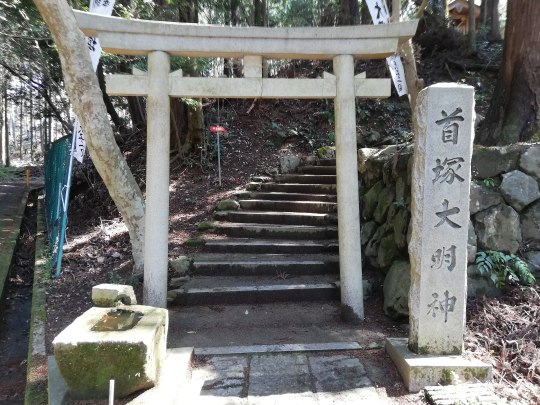
The Kubizuka shrine in 2019 (wikimedia commons)
There is yet another variant tradition about the final fate of Shuten Dōji: after his death he became a vengeful spirit, and then turned into a tsuchigumo, just to be defeated by Raikō and his retainer Tsuna for a second time.
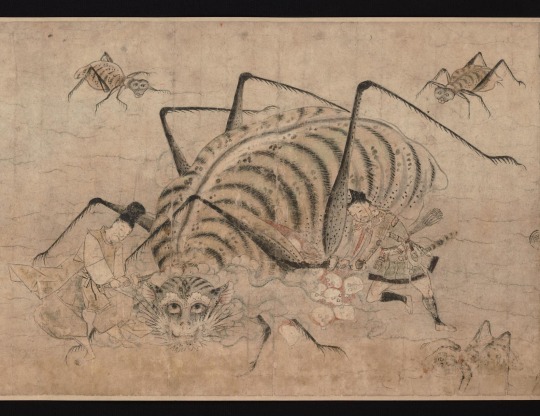
Raikō and Tsuna battling tsuchigumo, as depicted in Tsuchigumo no Sōshi Emaki (wikimedia commons)
Interestingly, it has been argued the tale of Shuten Dōji was at least in part based on that of the tsuchigumo Kugamimi no Mikasa (陸耳御笠), who resided on Mt. Ōe according to Tango Fudoki Zanketsu (丹後風土記残欠). The tale is not preserved fully, though, so all we know for sure other than the location is that the hero opposing him was Hikoimasu no Miko (日子坐王), a stepbrother of emperor Sujin (he is also attested in other sources). A second tsuchigumo, Hikime (匹女) is successfully defeated, but the fate of Mikasa is left unspecified in the surviving sections. This obviously makes further comparisons difficult. The topic of tsuchigumo cannot be dealt with here due to space constraints, but I promise I will return to it in a future article.
The supporting cast of Shuten Dōji
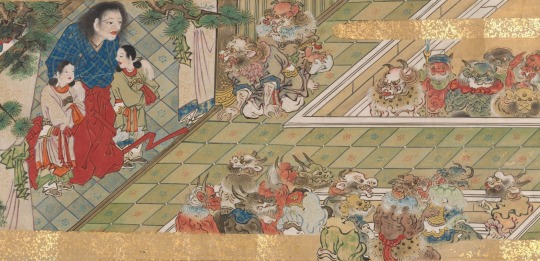
Shuten Dōji in his human form and his oni henchmen (NYPL Digital Collections)
Something that requires further discussion is the matter of the underlings of Shuten Dōji, since it is a topic directly relevant to Touhou. You might have noticed I actually avoided referencing them in any meaningful capacity in the summary of the legend. That’s because they actually do not play a major role. There also wasn’t any consistent view regarding their number or names. However, the version which came to be standard in the Edo period lists four of them - an obvious mirror of Raikō and his entourage. As a matter of fact, both groups even share the same moniker, Four Heavenly Kings.
This idea predates the Edo period, though. An earlier variant based on picture scrolls created by Kanō Motonobu already lists four servants of Shuten Dōji: Gogō, Kiriō, Ahō, and Rasetsu (yes, an oni named Rakshasa). However, two additional oni at his service are also listed, Kanakuma Dōji and Ishikuma Dōji. They are described as his personal guards, and as, well, dōji. It is clear the term is used in a literal sense here - they are said to look like “overgrown adolescents”. Two different subordinates are mentioned in another picture scroll: Kirinmugoku (麒麟無極) and Jakengokudai (邪見極大). However, they do not receive any characterization, or even physically appear in the narrative. Shuten Dōji shouts their names when he is about to die, and the very assumption that he’s referring to his oni subordinates is conjectural. The same version states that there were at least ten oni in the fortress so it’s not like it’s an implausible assumption.
The group of four oni returns in the standard Edo period version, where their names are Hoshikuma (“Star-bear”) Dōji, Kuma (“Bear”) Dōji, Torakuma (“Tiger-bear”) Dōji and Kane (“Iron”) Dōji. There’s also a fifth oni who is not a member of the group of 4, but shares the same naming pattern, Ishikuma Dōji. He actually gets a handful of lines, though they do not really provide him with much of a character beyond establishing he likes sake, that he eats humans, and that he is loyal to Shuten Dōji. Kane Dōji also gets a single line… explicitly alongside Ishikuma and multiple other nameless oni, though, and it boils down to announcing they will go down fighting because without their leader they no longer have a place to go.
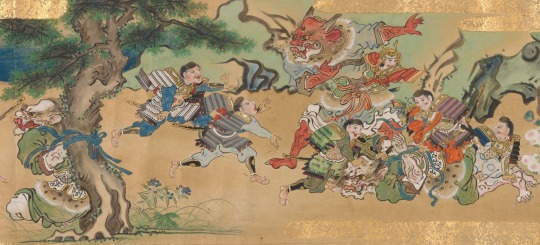
Defeat of the oni (NYPL Digital Collections)
Ibaraki Dōji: Shuten Dōji’s only equal?
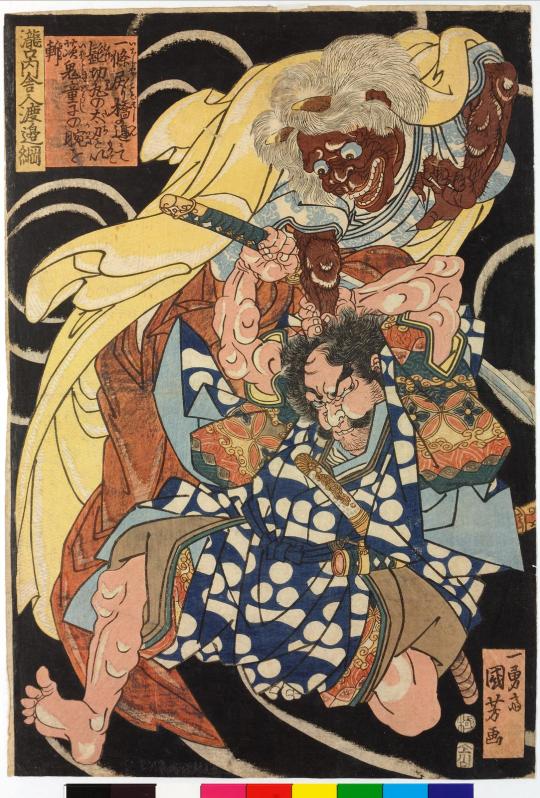
Watanabe no Tsuna battling Ibaraki Dōji (wikimedia commons)
A further unique case is that of Ibaraki Dōji, who actually acquired some fame as an individual character, and today is sometimes cited as an example of an oni equally archetypal as Shuten Dōji. Despite being portrayed as a close associate of Shuten Dōji, Ibaraki Dōji to my best knowledge isn’t counted among the Four Heavenly Kings in any version. The character of the connection is evidently more nebulous. I know an assertion that a tradition presenting Ibaraki Dōji as Shuten Dōji’s wife is attested is repeated as fact on wikipedia and various at least semi-credible websites, but there is never a citation provided, and no version of the narrative covered in articles and monographs I have access to includes such an element. I am not claiming it is impossible, though I do feel the fact it doesn’t come up in any paper or monograph discussing either figure I have access to doesn’t mention to might indicate it’s either a recent reinterpretation or a very obscure local variant. Note this is not meant to be an argument against any Touhou ships. What I can say with certainty is that Ibaraki Dōji’s gender is actually a matter of occasional academic dispute. In the versions of the basic Shuten Dōji narrative which mention this oni, he is pretty firmly male. However, he is said to be capable of taking the form of a woman. Noriko T. Reider argues that on this basis it can be effectively assumed that at the very least this specific oni can be considered genderless or capable of freely changing their gender, though she tentatively extrapolates this ability to oni in general. While Ibaraki Dōji’s gender changing adventure is technically its own legend, a reference to it was incorporated into the basic Edo period version of the Shuten Dōji narrative. During the feast, the latter mentions in passing that the former, his trusted ally, lost his arm in a fight with Watanabe no Tsuna during one of their Kyoto raids, after failing to abduct him while disguised as a woman. He clarifies that the arm was later recovered, but not particularly many details are provided. The rivalry between Tsuna and Ibaraki Dōji subsequently comes into play after Shuten Dōji’s death, when the protagonists are about to exterminate the other oni. Ibaraki charges him and they two fight without a clear winner for a while, until Raikō intervenes and kills the oni. I would argue that despite him being responsible for dealing the killing blow, it is Tsuna who should be considered Ibaraki’s nemesis, though. Interestingly, at some point ZUN considered featuring a character based on him in Wild and Horned Hermit (source). That obviously did not come to pass, though. Tsuna already fights an oni in Heike Tsuruginomaki, and many other variants of the story were written subsequently, with the noh play Rashōmon being the most famous. Curiously, the oldest version makes no reference to Shuten Dōji, and the oni actually resides on Mt. Atago, but by the Edo period the two were regarded as allies operating from Mt. Ōe. The details are otherwise generally similar across all of the sources. Raikō sends Tsuna on an errand. He encounters a woman on the Modoribashi Bridge in Kyoto, but as soon as he offers to take her with him she turns into an oni. Thinking quickly, he cuts off the creature’s arm, which is enough to make them flee. He keeps the severed limb as a trophy. Some time later, he is visited by an old woman who he assumes is his aunt... but who turns out to be the same oni, who uses a brief moment of confusion to recover the arm and fly away.
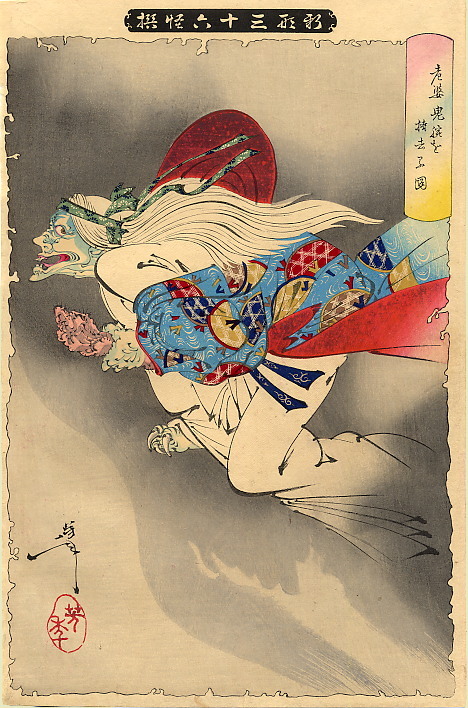
Transformed Ibaraki Dōji, as depicted by Tsukioka Yoshitoshi (wikimedia commons)
The legend of Ibaraki Dōji was evidently reasonably popular in the Edo period, and could even be utilized to comedic ends. One example is an Edo period satirical pamphlet, Thousand Arms of Goddess, Julienned: The Secret Recipe of Our Handmade Soup Stock, written by Shiba Zenkō and illustrated by Kitao Masanobu. Here the one-armed Ibaraki Dōji is one of the figures interested in leasing one of the now detached additional arms of the Thousand-Armed Kannon, who has apparently fallen in dire straits (“business slumps are inevitable, even for a Buddha”, comments the narrator, alluding to the financial conditions of the 1780s). As we learn, after making a purchase Ibaraki is disappointed by the lack of hair, and promptly hires a craftsman to add it:

Original translation by Adam L. Kern; reproduced here for educational purposes only. I am not responsible for the typesetting.
In my recent Ten Desires article I’ve already discussed the oni of Rashomon as a character in legends about Yoshika no Miyako, which I won’t repeat here. It will suffice to say that this conflation effectively made Ibaraki a penchant for poetry and fine arts, and that it indirectly put him in the proximity of the pursuit of immortality. Whether this is why ZUN made Ibaraki’s counterpart a wannabe immortal (“hermit”) is difficult to ascertain, but it does not strike me as impossible. The oni of Rashomon actually appears in at least one more legend which similarly portrays him as an enthusiast of the arts, though to my best knowledge this one never came to be reassigned to Ibaraki Dōji. It is centered on a famous biwa player, Minamoto no Hiromasa, who has to resolve the case of mysterious theft of an instrument from the imperial palace. As you can expect, it is revealed to specifically be an exceptional biwa, which bears the name Genjō. Hiromasa surveys the city in hopes of finding it, and eventually hears its distinct tones while passing near the Rashomon gate. He quickly realizes an oni is playing it. He politely asks if he can have it back, since it’s a treasure of the imperial court… and the oni eagerly obeys, thus bringing the story to a happy end. However, we are told Genjō acquired supernatural qualities in the aftermath of the theft, and only played when it felt like it, as if it was a living being. There is a variant which reveals that the oni of Rashomon was in fact the ghost of Genjō’s original maker, a craftsman from India. In this version, Abe no Seimei has to intervene to recover it, and the oni only agrees to return it after being promised a night with a woman he fell in love with who resembles his deceased wife. There is no happy ending here, though, as the woman’s brother convinces her she needs to kill the oni. She fails, and meets such a fate herself instead. It seems that the reader’s sympathy is actually supposed to be with the oni in this case.
Conclusions, or why you should make your own Deva of the Mountain
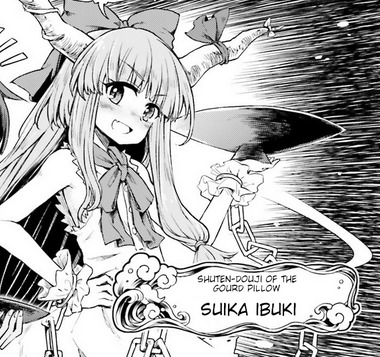
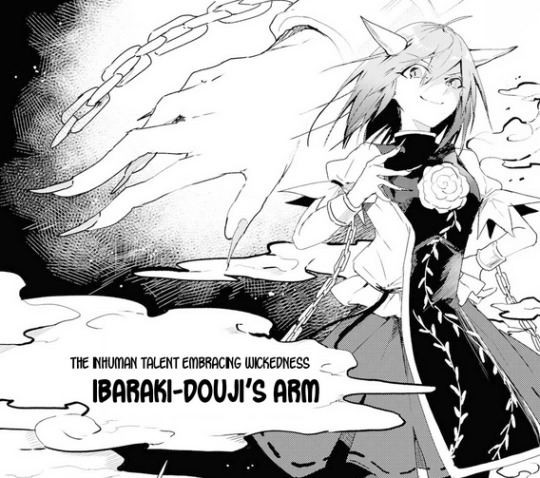
Obviously, there is nothing novel or clever about stating that the two figures this article is focused on, Shuten Dōji and Ibaraki Dōji, correspond to Suika and Kasen respectively. You can learn that from the official media itself, after all. Funnily enough, it seems this might have been even more blunt, judging from unused ideas for referencing the legend to an even greater degree in WaHH, with the defeat at Mt. Ōe as the explanation why oni reside… well, elsewhere (source). Granted, it would also be a disservice to ZUN to say he only created anime girl versions of the classic oni. He effectively created his own versions of both Shuten and Ibaraki - for every similarity between the irl background I’ve described and Touhou, there is also something brand new. That is part of what makes Touhou compelling, I would argue. Naturally, the fact that the group Kasen and Suika belong to is referred to as the Four Devas of the Mountain shows clear inspiration from the Edo period version of the original legends. However, Suika and Kasen are counted among the four, which is obviously an innovation. Additionally, while Yuugi is naturally named after Hoshikuma Dōji, who you were able to meet earlier, save for the name she is effectively a fully original character. Her ability references the Analects of Confucius, rather than anything directly tied to Shuten Dōji. And, on top of that in all honesty, she has more character than any of the additional oni appearing in the real legends. ZUN, as far as I am concerned, created a more than worthy addition to the classics. What about the much discussed fourth deva? I think it’s safe to say that in the light of the discussed material there simply isn’t a single most plausible option. As I stressed already, there’s no consistent group of oni appearing alongside Shuten Dōji, and it cannot be said that the Edo period version is clearly what should be treated as true in Touhou. ZUN picked what he liked from many versions. For what it’s worth, so far all of the oni forming the Four Devas are based on those who share the moniker of dōji, so that’s the closest we have to a theme. As I already said earlier, this term can be simply translated as “child” (or “lad”, though I think a gender neutral option is more apt since we are talking about Touhou here, ultimately). However, it has a more specific meaning when applied to supernatural beings. In this context it refers to a category of ambiguous figures characterized by “vitality, (...) hubris, and (...) unpredictability”, as well as fondness of violence, as summarized by Bernard Faure. Shuten Dōji, and by extension his underlings, are obviously the dōji par excellence. However, the term could also be applied to benevolent, or outright divine beings. That, however, goes beyond the scope of this article. I personally think despite the possible dōji theme the fourth slot will never be filled, ultimately. ZUN likes leaving gaps in established groups - there are types of tengu which were a part of the background for well over a decade, for instance. I think these are left as paths to make ocs with an instant excuse to interact with canon characters. Despite ZUN’s generally pro-fanwork stance I do not think I’ve ever seen anyone make this point. As far as I am concerned, the conclusion is clear: it’s entirely fair game to invent characters to fill the empty spot. There’s even a solid case to be made for reinventing oni from other legends as members of the Four Devas - remember that much of Ibaraki Dōji’s character was borrowed from a nameless oni from a legend about the Rashomon gate, as I discussed last month.
Bibliography
Bernard Faure, Rage and Ravage (Gods of Medieval Japan vol. 3)
Michael Daniel Foster, The Book of Yokai. Mysterious Creatures of Japanese Folklore
Adam L. Kern, Thousand Arms of Goddess, Julienned: The Secret Recipe of Our Handmade Soup Stock, written by Shiba Zenkō and illustrated by Kitao Masanobu (translation and commentary), in: An Edo Anthology: Literature from Japan’s Mega-City, 1750–1850
Keller Kimbrough and Haruo Shirane (eds.), Monsters, Animals, and Other Worlds. A Collection of Short Medieval Japanese Tales
Irene H. Lin, The Ideology of Imagination: The Tale of Shuten Dōji as a Kenmon Discourse
Michelle Osterfeld Li, Human of the Heart: Pitiful Oni in Medieval Japan in: The Ashgate Research Companion to Monsters and the Monstrous
Noriko T. Reider, Shuten Dōji: "Drunken Demon"
Idem, Japanese Demon Lore
Idem, Seven Demon Stories from Medieval Japan
also check out the scans of an amazing Shuten Dōji picture scroll from the NYPL collection here!
165 notes
·
View notes
Text
give a warm welcome to our 32 not-pink-enough contestants !!!

every single one of these characters has been accused of "not having pink enough hair to qualify for a main tourney" . the question is -- who is the best "pink" haired character of all time ? on 10/20/2023 , we'll begin voting to figure that out !!!!
ROUND ONE MATCHUPS
Junko Enoshima - Danganronpa VS Chiaki Nanami - Danganronpa Whitney - Pokemon VS Nao Egokoro - Your Turn to Die Sakuya Sakuma - Act! Addict! Actors! VS Sakura Minamoto - Zombieland Saga Crona - Soul Eater VS Ritsu - Assassination Classroom Kaz Kaan - Neo Yokio VS Kakyoin Noriaki - Jojo’s Bizarre Adventure Sara - Tales of Link VS Sucy Manbavaran - Little Witch Academia Power - Chainsaw Man VS Sayori - Doki Doki Literature Club Pearl - Steven Universe VS Sylvie Ashling - Epithet Erased Nomi Nomi - I Was a Teenage Exocolonist VS Kipo Oak - Kipo and the Age of Wonderbeasts Clover Field - Zero Escape VS Mitsuri Kanroji - Demon Slayer Koyuki Himekawa - Magical Girl Raising Project VS Satori Komeiji - Touhou Ruby Kurosawa - Love Live! VS Princess Iris - Lolirock Vi - Arcane VS Duck - Princess Tutu Mizuki Akiyama - Project Sekai VS Kokomi Sangonomiya - Genshin Impact Kirio Nekoyanagi - The Idolm@ster VS Marika Kato - Mouretsu Pirates Iono - Pokemon VS K-Angel - Needy Streamer Overload
157 notes
·
View notes
Text

Day 21 - Frontier Guards
For Inktober this year I grabbed a bunch of Age of Empires 2 technologies as prompts and am drawing a Touhou character for each.
<- Previous Next ->
#inktober#my art#kasen ibaraki#okina matara#yukari yakumo#touhou project#touhou#I don't know what they're up to#standing out above a nearby Outsider city#You tell me
26 notes
·
View notes
Text

start of my new project: Patting every Touhou character
#1 - Reimu Hakurei (PC-98)
what a silly girl... i bet she won't turn grumpy with age! ... may the start to a long journey begin 🎉
333 notes
·
View notes
Text
Touhou USAmerican AU update
Don’t ask how the characters all know each other, because I have nothing for now. But one idea I have floating around is that they’re all magical girls and/or involved with supernatural incidents and are a team who solves them.
I’m still working out the details of this AU and debating keeping ALL of the supernatural/magical aspects of the original characters/universe.
I also don’t know exactly how many characters I’ll include. But I might have my OC group Resonate in this AU as OCs.
The AU also takes place in Colorado, as suggested by @counterattacker.
Reimu
Early 20’s
Seems practical but really isn’t
Seems meek but really isn’t
She’s friendly to strangers but is different and more assertive around Marisa
Done with (Marisa’s) shit
Banters with Marisa
Marisa always drags her into a bunch of incidents
She’s the one who has to resolve the incidents
Actually very formidable in a fight
Has burnout
Likes to take it easy but can’t
Eats rice with every meal. Even stuff like pizza
College student who is overwhelmed by all her duties
Plays violin but isn’t really that good
Half-Latina
Trans woman
Bisexual
Practicing Shinto in the USA
Has a crush on Marisa…
She’s stuck with Marisa as her sidekick and they’re always together
Marisa
Early 20’s
Feral
Steals things a lot… or rather “borrows permanently”
One of the things she stole was Reimu’s heart
Owes Reimu a lot of money
Flirts around as a joke but secretly really would take a bullet for Reimu
Loves Reimu a lot but doesn’t express it candidly
Has an inferior complex and perceives Reimu as better than her
Obsessive
Boisterous
Likes pranks
Banned from Costco
Likes to scare people with her witch image
Loves Halloween
Gets into trouble a lot
Lesbian
Probably has ADHD
Reimu’s sidekick
Yukari
In her late 30’s
She’s a senior magical girl, mentor to Reimu and Marisa
Older sister type
Annoys Reimu
Doting but in an annoying way
Always says “when I was your age…”
Kind of like a (irresponsible) guardian to Reimu and Marisa
“Ara ara”
Mischievous
A bit like Princess Celestia but mixed with Eda from The Owl House
She’s the voice of reason for Yuuka
Cirno
Annoying kid
Precocious but also dumb
⑨ years old
Can’t do math
Tiny
Drives everyone insane
Annoying high pitched voice
Pretends to be an ice fairy, is actually somehow convincing
Loves shaved ice
Loves winter
A menace
Has an obsession with capturing and freezing frogs, but everyone else forbids her
Has stomped through Yuuka’s flowers before
Never seems to catch a cold. She thinks this is because she’s an ice fairy. It’s actually because idiots don’t catch colds.
Clownpiece
Another annoying kid
12 years old
Feral
Self-proclaimed fairy of hell
Edgy
Comes from a family of clowns
Draws cursed art
Probably has deviantart despite being too young
Likes wolves
Mixed-race (Native American, Japanese, White)
All her clothes seem to have the American flag on them
Her parents are patriotic and pick out all her clothes
Yuuka
Early 30’s
The “vengeful lady next door” who is just very overprotective of her flower garden
Known for having a beautiful and extravagant garden in her yard
She’s also a beekeeper
Kind of lonely but doesn’t admit it
Brutally honest
Makes children cry
Friends with Yukari
She acts soft around Yukari. She might have a crush on her
Patchouli
19 years old
Quiet and blunt girl who frequents the little town’s small library
Doesn’t show much expression
Hates her name
Done with life
Has read nearly all the books in the small library
Know-it-all
Knowledgeable about math, astronomy, chemistry, literature, and folklore
Friends with Alice
Nazrin
10 years old
Loves cheese
Innocent and a bit shy
Adventurous
Suwako
7 years old
Tiny even for her age
Energetic
Loves to go to the pond and play with the frogs
Often pretends to be a frog
Can’t swim
Half-Korean
Seems to be a “frog whisperer.” Frogs are somehow drawn to her
Again, she is ridiculously tiny
Wriggle
15 years old
Nobody knows her real name
Non-binary transmasc but still uses she/her
Loves cats but is allergic
Sakuya
Mid 20’s
Dependable but scary
Remilia and Flandre’s aunt and caretaker
Badass who can fence
Half-Japanese, half-French
Flandre
11 years old
Remilia’s younger sister
Feral edgy chaos girl
Vandalizes the school’s textbooks
Looks up to Marisa
Loves flan
Actually a really good pianist
French
Likes horror movies
Banned from three grocery store chains
Bites people
Remilia
13 years old
Flandre’s older sister
French
Kind of spoiled
Snobby
Thinks her sister is uncouth
Ojou-sama laugh (“ohoho!”)
Rinnosuke
27 years old
One of Reimu’s friends in college, seemingly always classmates with her
Older brother figure to Reimu
Usually quite chill and polite
Good at math
His hobby is JRPGs
Addicted to ramen
Lowkey a weeb (despite being Japanese)
He’s gay
He’s single because he “can never seem to find another single guy”
Alice
19 years old
British
Has a British accent
Doll collector
Shy
#touhou#reimu hakurei#marisa kirisame#yukari yakumo#cirno#clownpiece#yuuka kazami#patchouli knowledge#nazrin#suwako moriya#wriggle nightbug#sakuya izayoi#flandre scarlet#remilia scarlet#rinnosuke morichika#alice margatroid
21 notes
·
View notes
Note
I feel like I don't have enough Canon Knowledge to make touhou fanwork. which is nuts because I've been a fan since i was 12 played all the games up to wbawc and read all the manga and yet every day is like who the hell is renko where did all these other ladies come from what the fuck is oil fire
hey, we're talking about a series that, judging by the age stated on your blog, has been getting regular installments for about as long as you've been alive. I think it's pretty understandable to be a bit daunted by the sheer pile of stuff that ZUN has managed to make over the past 26 years of fairly constant output. and that's not even getting into fandom stuff like the ol' Oil Fire.
point is, it's a lot. The good news is, this is a series where the answer to a question like 'what does the Hakurei shrine look like?' is 'it depends on who drew it.' You've got a lot of wiggle room, and that's before getting into things that have changed over time, or places where different sources show different takes on things. If there's a particular official work that you like and you want to write something with its characters, odds are about 95% that you'll get all the details you really need if you read the characters' various profiles and read/play the main works where they've appeared. If there's some bit of canon you want to include but are unsure of, TouhouWiki can probably point you to a good source for it at worst. Even with Reimu and Marisa, it's less about discerning their True And Eternal Unchanging Nature and more about picking which canon take on them you wanna focus on.
and personally, between
a story that contradicts some fairly concrete canon bits, by someone who's into the series and interested in getting into the characters' heads
vs. a story that doesn't contradict canon on any firm factual stuff, by an author who isn't really invested in the characters or setting. (A person who probably has a lot of power level arguments, in my experience.)
I'd rather read the former every time.
106 notes
·
View notes
Text
I love going to the Touhou Wiki to learn a little about one of the many interesting character designs and on the side I see "Age: Dead"
65 notes
·
View notes
Text
Mike's Media Medley; September and October 2024
so it turns out having 3 jobs and being a part time student means i dont wanna do anything ever so this will be kind of a lightning round in which i just state some brief thoughts and give a score on all the things i experienced for the very first time in september and october 2024.
Movies (2024 releases): Blink Twice, My Old Ass, Transformers One, Saturday Night, The Wild Robot
Movies (non-2024 releases): Rear Window (1954), In The Heat of the Night (1967), Tár (2022)
Video games: Touhou Mystia's Izakaya (2021), Cult of the Lamb (2022), Sonic x Shadow Generations, Balatro, and Mouthwashing (2024)
Blink Twice

this is zoe kravitz's directorial debut and im gonna be honest this kind of slayed. i saw some people complain about how long the build up goes but i think the build up makes the twist work even better. speaking of the twist PLEASE take the warning at the beginning of the movie very seriously.
really enjoyed it and might watch it a second time to see if i can pick up new details but i think seeing it two times will exhaust its appeal to me, i think that's like the max i can enjoy it. really good movie but it hinges on the twist.
btw the title card popping up EXTREMELY briefly during a camera flash? 10/10 no notes
77.5/100
In The Heat of the Night (1967)

i think this movie is like, Fine. definitely a solid movie with good performances. i think the cultural context it was made in elevates it and i understand how BOLD this movie would've been back in the 60s (especially when sidney poitier slaps a white man) but as far as like. police procedurals/mystery solving etc goes its not my favorite but that's not necessarily the point.
decent watch, made better with the cultural context of its time
65/100
My Old Ass

this movie was ALRIGHT and i barely remember anything about it. i didn't hate it i don't think. i didn't love it. i think only one moment made me truly laugh and i can't even remember what that moment was.
40/100 on the basis of me liking it i.e it didnt piss me off like some other movies ive watched but maybe the score should be lower because i dont remember a thing about it idk
Rear Window (1954)

i meant to watch this in theaters for its 70th anniversary but i had to work both days it was showing so i rented it from my local library. this is my first hitchcock film and i thought it was REALLY good, definitely way better than i was expecting based on plot synopsis alone but that just shows i was a fool sorry for doubting alfred hitchcock
that being said watching old movies rly makes you notice how many young women get paired up with men twice their age and its narsty and i wanted the mc to die for most of the movie. im only half kidding. didn't care so much for the personal drama side between crusty ass man and his girl tbh
incredibly good suspense. might watch it again but idk if i would like it as much on repeat viewings
80/100
Saturday Night

i couldnt understand a word anyone was saying in this movie because of weird sound mixing and how intrusive the music was especially at the beginning which feels rly uh bad considering how talky this movie is.
wish i could give it a higher score but alas i didnt hear 75% of the plot or jokes which SUCKS because I AM RACHEL SENNOTTS BIGGEST SHOOTERRRRRR
40/100
Tár (2022)
i was kinda bored by this. i got the point i just got bored. i dont rly remember much except thinking it was incredibly funny she got punished by the narrative into orchestrating video game concerts
technically very well made and cate is obviously putting her pussy into this it was just not for me.
45/100
Transformers One

now this is what im fucking talking about
i didnt think i remembered much about transformers but i watched this w my mom and the whole time we were going omg starscream omg soundwave omg i am optimus prime yassssss
choreography is fucking epic. jokes landed for me 75% of the time. but the obvious highlights are the character development and backstories for optimus and megatron. this movie was epic and you should watch it for free on your favorite pirate website because fuck paramount lives and SHOUT OUT TO BRIAN TYREE HENRY OF LEMON FAME WHO HASNT MISSED YET IM GONNA WATCH ATLANTA ONE DAY KING I PROMISE
85/100
The Wild Robot
gorgeous movie. lupita fucking killed it. cried at the end. dont think i would rewatch it much but i greatly enjoyed it. no notes go watch it
85/100
viddy games
Balatro (2024)

girl help
Cult of the Lamb (2022)

ADORABLE art style, lots of mechanics but not necessarily very in depth. the perks just feel kinda eh but i love the aesthetic and the music. also usually not big on things with religious themes but i let this one slide cuz its a cult doing. bad cult things LOL. also i love my little guys
Mouthwashing (2024)

theres literally so much i want to say about mouthwashing but what can i say that hasnt been said already...ill save it for my end of the year review because it is DEFINITELY making my top 7 unless these final 6ish weeks of the year are full of fucking bangers
Sonic x Shadow Generations (2024)
ok so i never played the og sonic generations much, i rented it on redbox once and my brother rented batman arkham city at the same time and we had one xbox so i barely played that thing before we had to return it becuz his stupid ass hogged it all weekend and im not bitter about this still at ALLLLLLLL but god i fucking love shadow the hedgehog so much hes truly the little guy ever
Touhou Mystia's Izayaka (2022)
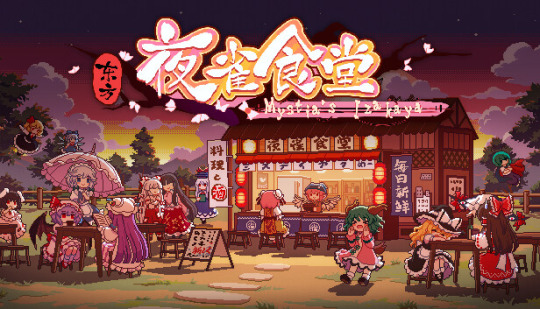
so i haven't sunk a WHOLE lot of hours into this game because i keep getting distracted by other things but i think its VERY cute and chill and pretty fun and i might be tempted into the touhou project dark side maybe
13 notes
·
View notes
Text

She's been rotating in my head like a microwave recently and I just needed to draw her again
Artists note:
I wasn't really happy with the way I drew her in my style, so I decided to try drawing her again, as well as doing some more experimentation with my style.
(Also pardon how tense Zanmu looks in this lmao, Hisami probably pissed her off that day lol)
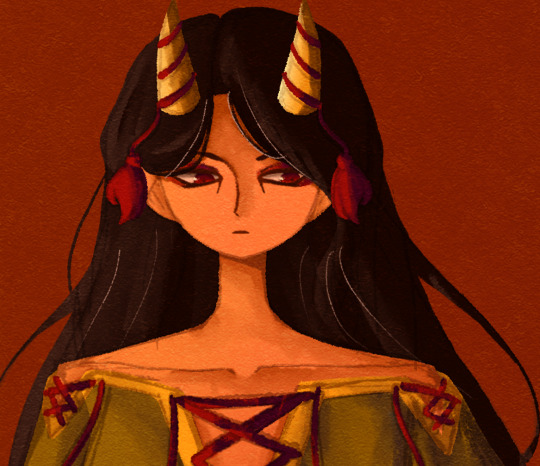
as I was drawing her, I recently went to the (now finished) Touhou wiki page for her and wanted to capture the graceful side to her character as well. I was also inspired by that one tier list of the different ways Touhou characters refer to themselves in Japanese, and Zanmu refers to herself the same way old people do (lmao) so I added some white hairs and wrinkles at the corners of her eyes. I could've gone a bit harder on the wrinkles but I imagine she's probably aged gracefully. I also wanted to include some of the red eyeshadow that I see in other peoples art of her because it looks nice.
Also, I've recently been trying to improve upon the way I draw different body types with women, because I would sometimes make the shoulders too wide and it wouldn't look right. I feel like I've gotten better at that with this drawing.
I also wanted to practice drawing clothing folds as well as gaining a better understand of how her outfit works.
One last thing to note, the vibes for Zanmu in this piece were inspired by Renata Glasc from LoL (I don't play league I just like Arcane and animation and character design analysis videos for it).
Also on the topic of characters Zanmu reminds me of, she reminds me of ToTK Ganondorf for some reason maybe it's the horns but like, I haven't finished the game so no spoilers. Also, I think I brought this up in a previous post, but she reminds me of Meruem from Hunter X Hunter and Hisami reminds of Shaiapouf, like especially with the latter, those two have the same vibes.
#touhou project#art#fanart#touhou fanart#touhou 19#zanmu nippaku#zanmu#unfinished dream of all living ghost#also pardon the lack of an interesting pose#just needed a pose to focus on the way the sleeves fall
171 notes
·
View notes
Note
Hi Alcibiade! 💖 I'm glad that you are interested in collaborating with me! Honestly, I don't have any concrete ideas at the moment, but the mention that you can draw either Touhou- or Danganronpa-related line drawings reminded me of the one I've been secretly working on in my head about Hajime and Nagito getting lost in Gensokyo. Not that there's anything specific idea that I want you to draw, but I thought it might be interesting to share some ideas about it, so I'll write some down here.
First of all, this type of story is called "幻想入り(Gensou-iri)" in Japanese fandom, and it is one of the themes that has been the subject of a lot of fan creation. For example, there are many stories about video game characters who got lost in Gensokyo, such as Kirby, Zelda, or characters from Final Fantasy. In fact, it is canon that people from the outside world can wander into Gensokyo, so it is easy to imagine this kind of story.
Anyway, the reason I fantasize about Hajime and Nagito going to Gensokyo is because I want to see Nagito play a game of Japanese gambling with Youkai. XD There is a character who first appeared in TH18, a Youkai named Sannyo Komakusa, who runs a gambling den on Youkai Mountain. While the den isn't described in much detail in the game, it's depicted in Lotus Eaters, one of the official manga. I imagine Hajime would be very cautious around the Youkai, but Nagito would fearlessly accept the Youkai's challenge to a game of chance in Sannyo's gambling den. He would then draw in more and more Youkai, who would be amazed by his extraordinary luck. Later, at a banquet at the Hakurei Shrine, Reimu (she is also lucky!) and Nagito would face off in a game of chance, having a great time late into the night. By the time they wake up, Hajime and Nagito will have returned to their world... And that’s the story I have in mind.
I have other little ideas, like Mamizou (one of the Youkai from the outside world) saying "I know a lot about the outside world" and getting involved with Hajime and Nagito but the knowledge she has is so outdated that Hajime gets confused, and Aya being amused by Nagito's good luck and offering to interview him, and many other ideas. At the moment I am not writing down any specific ideas or drawing anything, but I would like to put aside the background of how it happened, etc., but I would like to draw just the gambling scene at some point.
Sorry if my story seems a bit all over the place. X( I'm sure there are all kinds of fun things we can do together, and I'll send you another message if I come up with any good ideas! Have a great day! 🫶💕
Hi Asaka! 🥰
Thank you for sharing so many great ideas with me!!🥹💕 I'm not sure if you wanted me to keep them all to myself or not, so please tell me if you want me to take down this answer ^^" it was a pleasure to read the stories you had in mind, and I wanted to respond when I could take the time to pull the best response possible out of my mind !
It's true that there are all kinds of things we can do together, so please don't hesitate to send another message if you have anything in mind! But I also really like the ideas you mentioned here, and I'm excited by these Gensou-iri stories because this way, we can gather different interests we have in common! :)
The gambling scene looks very inspiring, so I'm not surprised to learn that you wanted to draw it! I think that the two other stories you mention, one with Aya and one with Mamizou, seem both easier and harder to create for us together right now: easier because I completely see how they could be written as relatively small and independant (yet related!) comics, but also harder because you can't really "reduce" them to a small drawing that we could make together as a starting point, I think. But I really like them nonetheless!
So I decided to focus on the gambling scene with Reimu, if it's ok for you. It took me ages to respond to this ask, because I kept asking myself how I should proceed! At first, I thought that I had to do half of the drawing and then lend it to you, but I realized that it would have been frustrating to you to just fill the empty space without having your word in the process :c So I had another idea: I just give you this drawing of Reimu defying a blank space (for now!) and you do absolutely whatever you want with it (you can add all the colors or shadows you want, add the setting, you can add Nagito and Hajime... it's up to you!) and then you give it back to me, and I can add other things if you left space, or do the color, or anything really. This way, you can do whatever you want and if there are things that you wanted me to do, you just have to leave the space and I can do it afterwards ^^ I thought about drawing Hajime and Nagito myself to give you a more finished drawing, but I thought that maybe you would have liked to draw them yourself. 😊💖 Anyway, let me know what you think of this idea :) and please feel free to modify everything you want to!

( I figured that drawing Reimu this way was a good compromise between your style and mine, because it gives me the opportunity to have fun with the composition like I’m used to, without having you cornered into a particular perspective or composition yourself. I hope you like it ! Because I don’t know a thing about japanese gambling games, I’ll let you draw the game you want if you don’t mind x’) )
Thank you for this ask full of lovely and funny ideas!!! 💕🖤
#ask#touhou project#danganronpa#my art#reimu hakurei#sorry again for taking so much time to respond#now I can respond back at a normal speed!#I'm looking forward to see what it will look like!#(almost forgot to put the drawing in the post)
12 notes
·
View notes
Text
Just saw a video on twt making fun of some woman in a bookstore picking up novels and saying "oh the main character fucks her uncle in this", "this author used to write KyloRey fic" and I have to ask how are fanfic authors comfortable exposing their professional lives to their fandom followers?
With as miserable and rabid as cancel culture has been re: creatives are you allowed to just say "yeah I write problematic stuff but I'm sorry for being white and I promise I'm a Good Person (TM) here's some pron for the female gaze"?
Does this only apply to erotica? I have a whole backlog of fanfic I've been meaning to reupload and I have three semi-active AO3 accounts, I wouldn't mind the extra eyes on my professional work but I've been very very reluctant to combine my fandom identities and my professional one because of cancel culture and also I don't think the ages of fictional characters matter I write a lot of Pokemon stuff lol
I'm also not sorry for anything I've written or said ever so there's that, there's no "oh I wrote this ten years ago I'm sorry it doesn't reflect my current values" my current values still include Pinecest
I'd rather have my legs cut off than ever bend the knee and it doesn't matter too much since my bf will be pulling in enough money in a few years that even if I got "cancelled" it'd be inconsequential but for now I am trying to make money
I just don't get how some fanfic authors are like "anyway here's my original stuff" and don't separate their identities like at all
Is it insanity or bravery? Am I just schizophrenic? I've got more victim points than anyone who would try to "cancel" me I just actively choose not to play retarded games since imo the only thing to be won are retarded prizes
Anyway the people making fun of those women in the video are mean however I think there's a good faith argument to be made that if you defend erotica and porn for women you shouldn't have a problem with l0li or ecchi anime content either--I would die for the right of a basement dweller to get off to his 5000 year old dragon l0li idgaf my principles are applied FAIRLY and EQUALLY to everyone the way that you should objectively apply your princples and opinions I would also take a bullet for you to consume reader inserts with uh whatever is the most mainstream thing about normie women these days lol
No I will not shame you for reading 50 shades of grey but I will also not shame some ugly fat 4channer for his doujinshi collection at the end of the day none of you are hurting anyone for what you get off to and the dating economy is garbage even if you're bisexual (like me)
It's all fictional and I think a lot of women especially on this website need to get off their high horse--Touhou yuri is primarily for dudes the same way Nitro Chiral is primarily for girls get over it
#authorblr#writers on tumblr#fanfic writing#authors of tumblr#authors#writing community#food for thought#proship#profiction#anti anti
9 notes
·
View notes
Text
my opinion of western Touhou fans will forever be defined by the one person who was going on about "Touhou characters age in real time according to Zun, so Reimu is in her 30s", only for it to be pointed out that he specifically said the series uses a rolling timeline, only for the response to be "who cares what Zun says"
13 notes
·
View notes